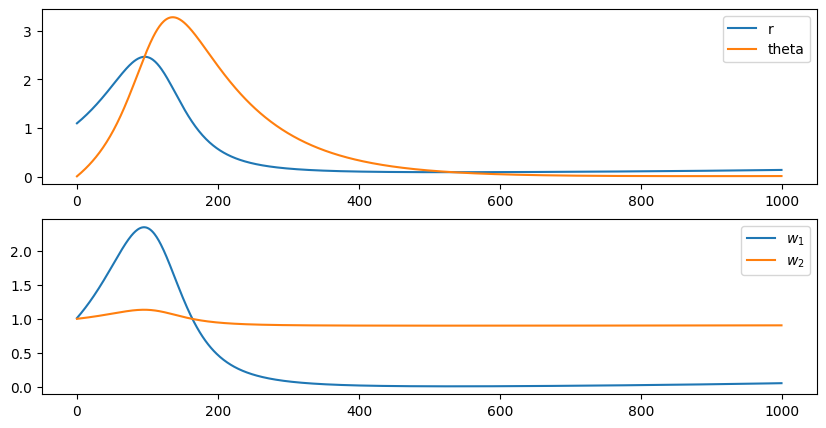#!pip install ANNarchyBCM learning rule
The goal of this notebook is to investigate the Intrator & Cooper BCM learning rule for rate-coded networks.
\Delta w = \eta \, r^\text{pre} \, r^\text{post} \, (r^\text{post} - \mathbb{E}[(r^\text{post})^2])
Intrator, N., & Cooper, L. N. (1992). Objective function formulation of the BCM theory of visual cortical plasticity: Statistical connections, stability conditions. Neural Networks, 5(1), 3–17. https://doi.org/10.1016/S0893-6080(05)80003-6
We first import ANNarchy:
import numpy as np
import ANNarchy as annANNarchy 5.0 (5.0.0) on darwin (posix).We will keep a minimal experimental setup, with two input neurons connected to a single output neuron. Note how the input neurons are defined by using the InputArrayclass, allowing to set r externally.
# Network
net = ann.Network()
# Input
pre = net.create(ann.InputArray(2))
# Output
neuron = ann.Neuron(
equations = """
r = sum(exc)
"""
)
post = net.create(1, neuron)We can now define a synapse model implementing the Intrator and Cooper version of the BCM learning rule.
The synapse has two parameters: The learning rate eta and the time constant tau of the moving average theta. Both are defined as global parameters, as we only need one value for the whole projection.
The moving average theta tracks the square of the post-synaptic firing rate post.r. It has the locality semiglobal, as we need to compute only one variable per post-synaptic neuron (it does not really matter in our example as we have only one output neuron…). It uses the exponential numerical method, as it is a first-order linear ODE that can be solved exactly. However, the default explicit Euler method would work just as well here.
The weight change dw/dt follows the BCM learning rule. min=0.0 ensures that the weight w stays positive throughout learning. The explicit Euler method is the default and could be omitted.
The psp argument w * pre.r (what is summed by the post-synaptic neuron over its incoming connections) is also the default value and could be omitted.
IBCM = ann.Synapse(
parameters = dict(
eta = 0.01,
tau = 100.0,
),
equations = [
ann.Variable('tau * dtheta/dt + theta = (post.r)^2', locality='semiglobal', method='exponential'),
ann.Variable('dw/dt = eta * post.r * (post.r - theta) * pre.r', min=0.0, method='explicit')
],
psp = "w * pre.r"
)We can now create a projection between the two populations using the synapse type. The connection method is all-to-all, initialozing the two weights to 1.
proj = net.connect(pre, post, 'exc', IBCM)
proj.all_to_all(1.0)<ANNarchy.core.Projection.Projection at 0x13df0d400>We can now compile the network and record the post-synaptic firing rate as well as the evolution of the weights and thresholds during learning.
When recording synaptic variables, you will always get a warning saying that this is a bad idea. It is indeed for bigger networks, but here it should be fine.
net.compile()
m = net.monitor(post, 'r')
n = net.monitor(proj, ['w', 'theta'])Compiling network 1... OK
WARNING: Monitor(): it is a bad idea to record synaptic variables of a projection at each time step! The simulation protocol is kept simple, as it consists of setting constant firing rates for the two input neurons and simulating for one second.
pre.r = np.array([1.0, 0.1])
net.simulate(1000.)We can now retrieve the recordings and plot the evolution of the various variables.
r = m.get('r')
w = n.get('w')
theta = n.get('theta')import matplotlib.pyplot as plt
plt.figure(figsize=(10, 5))
plt.subplot(211)
plt.plot(r[:, 0], label='r')
plt.plot(theta[:, 0], label='theta')
plt.legend()
plt.subplot(212)
plt.plot(w[:, 0, 0], label="$w_1$")
plt.plot(w[:, 0, 1], label="$w_2$")
plt.legend()
plt.show()
Notice how the first weight increases when r is higher than theta (LTP), but decreases afterwards (LTD). Unintuitively, the input neuron with the highest activity sees its weight decreased at the end of the stimulation.

